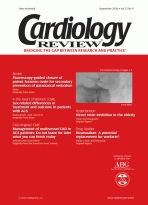Publication
Article
Cardiology Review® Online
Gender and cardiac outcomes
Author(s):
This year’s special issue on “Cardiovascular Disease in Women” contains articles in several areas of interest to clinicians concerned about the state of women’s health in general and the cardiovascular system in particular. First up, in a combined article in the Stroke and Arrhythmia Sections, Dr Margaret Fang discusses the problem of ischemic stroke in patients with atrial fibrillation and the roles of gender on treatment and outcome. Dr Robert Levine, one of our neurological consultants, comments for Cardiology Review. Next, Dr Anita Deswal offers a comparison of morbidity and mortality in men versus women with congestive heart failure and preserved left ventricular function, aka “diastolic” heart failure. Dr Deswal used an ancillary arm of the large multicenter Digitalis Investigation Group (DIG) trial to derive a patient population of 378 men and 341 women. Dr Deswal found that there are some interesting differences between men and women with this increasingly common form of heart failure. Dr Leslie Cho, a specialist in heart disease in women and a newcomer to Cardiology Review’s editorial board, draws the assignment to discuss the clinical implications of this study. In another very interesting paper, Dr Harry Hemingway and colleagues assess the public health impact of stable angina pectoris in women. Even though coronary artery disease is the most common cause of death in women in many developed countries (and stable angina the most common presentation of coronary artery disease), most population studies have focused on female patients hospitalized for acute coronary syndromes. The approach of Dr Hemingway and colleagues is therefore very welcome. This group has a very large database of more than 90,000 Finnish men and women aged 45-89 on which to base their conclusions. The similarities and differences between men and women are pointed out by the authors and discussed further by our editorial board member, Dr Richard Steingart, who is an expert in the field of women’s health. Finally, in an interesting report in the Imaging Section, Dr Ikenna Nwachukwu presents the case of a 65-year-old woman with a rare form of cardiomyopathy. Cine-images of the left ventricle illustrate the unique pathological features of this case. Another new consultant to Cardiology Review, Dr Hal Skopicki, explains what is currently known about the “takotsubo” (apical ballooning) syndrome.






